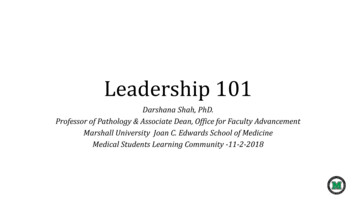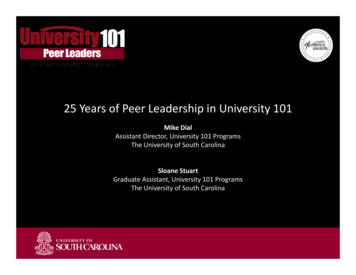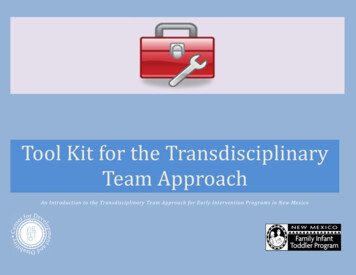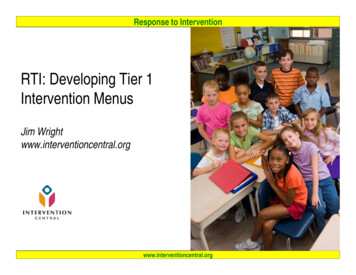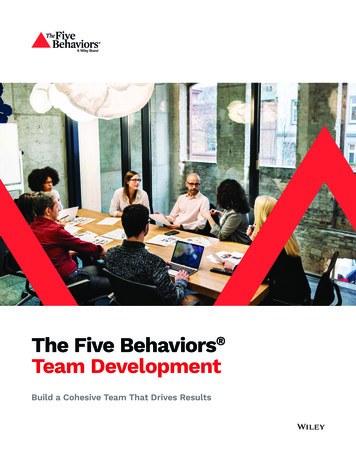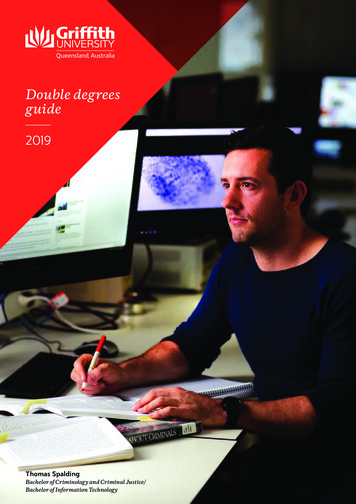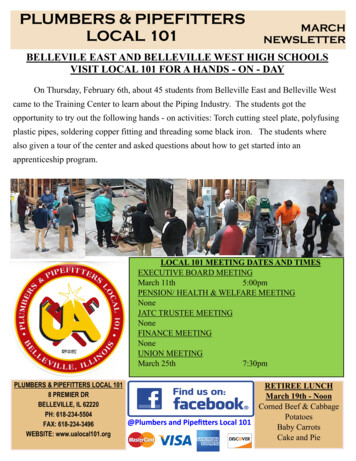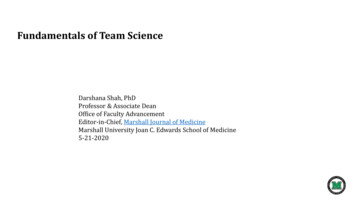
Transcription
Fundamentals of Team ScienceDarshana Shah, PhDProfessor & Associate DeanOffice of Faculty AdvancementEditor-in-Chief, Marshall Journal of MedicineMarshall University Joan C. Edwards School of Medicine5-21-2020
“Not finance. Not strategy. Not technology.It is teamwork that remains the ultimatecompetitive advantage, both because it isso powerful and so rare.”Patrick Lencioni, 2005The Five Dysfunctions of a Team: A Leadership Fable
Outline Overview: The “what” and “why” of Team Science What Team Science tells us about working together inresearch teams Identify key Team Science concepts you can use today Resources
TEAM examples What examples come to mind when youhear the word "team"?
TEAMS & TEAM EFFCETIVENESSDalenberg et al. 2009Salas et al., 2015Hughes et al., 2016McEwan & Beauchamp, 2014Littlepage et al., 2016
What is Team borations
“ Most of the work still to be done in science and the usefularts is precisely that which needs knowledge andcooperation of many scientists and disciplines. That is why itis necessary for scientists and technologists in differentdisciplines to meet and work together, even those inbranches of knowledge which seem to have least relation andconnection with one another”Antoine Lavoisier1793
NIH Roadmap InitiativeWhat novel approaches can be developed that have the potential to betruly transformative for human health?.NIH Roadmap: cadeofDiscoveryNIHRoadmapCF.pdf
Scientific Research TeamTransdisciplinaryCombines or integrates from more thanone field: concepts, methods, and theoriesLevel of Interactionand IntegrationMultidisciplinaryAn independent, sequentialprocess where team memberscontribute individually,representing the tradition of theirown discipline, and staying wellwithin their own areas of expertiseHighInterdisciplinaryA joint, interactive process where eachmember draws from his or her owndiscipline and specific perspective toaddress a common research problemUnidisciplinaryResearchers from a single discipline worktogether to address a common researchproblem.lowAm J Prev Med 2008;35(2S)J Investing Med. 2012 June ; 60(5): 768–775.doi:10.231/JIM.0b013e318250871d.
What is a Scientific Research Team? .think of it as a continuum .LowInvestigator-InitiatedResearchInvestigator works on ascientific problem, largelyon his or her own.HighLevel of Interaction and IntegrationResearch CollaborationIntegrated Research Team Group works on a scientific problem, eachbringing some expertise to the problem. Members work on separate parts, whichare integrated at the end. The interaction of the lead investigatorsvaries from seldom to frequent with regardto data sharing or brainstorming. Team works on a research problem with eachmember bringing specific expertise to the table. There are regular meetings and discussions ofthe team’s overall goals, objectives of theindividuals on the team, data sharing, and nextsteps. One person takes the lead while othermembers have key leadership roles in achievingthe goal.11
Scientific Research Team .think of it as a continuum .LowCollaborationInvestigator-Initiated ResearchHighIntegrated Research TeamClinical TrialsBioinformaticsDrug modificationBiotechnologynanotechnologymethod for deliveryCapital venture– tyNIH Field GuideScience Commons (http://creativecommons.org/science)
What is Team Science?Definition: integration of two or morescientific approaches to solve a complex,multifaceted problemIt is a collaborative effort to address ascientific challenge that leverages thestrengths and expertise of professionalstrained in different fields.
Team Science is a collaborative effort to address ascientific challenge that leverages the strengths andexpertise of professionals trained in different fields.National Research Council (2015) EnhancingEffectiveness of Team Science***
Why Team Science ?
Why TEAM Science? Complex 21st-century societal (health, social, environmental,energy, and technological) problems require cross-disciplinarysolutions Advances in technologies Vast data sets Enormously increased range of questions Research is increasingly conducted in teams across virtually allfields 90% of all work in science & engineering disciplines is done inteams
Why Team Science ?researchers; endocrinologists; pediatricians; internists; surgeons;exercise physiologists; nutritionists; behavioral researchers;psychologists economists—to name just a few types of specialistswww.ScienceTranslationalMedicine.org 10 March 2010 Vol 2 Issue 22 lic/expertBlog.aspx?tid 4&rid 1570NIH Roadmap is available at: http://nihroadmap.nih.gov/.Know your Network !!!!
Teams produce more highly cited research & patentsthan individuals.Mapping longitudinal scientific progress, collaboration, and impact of the Alzheimer’s disease neuroimaging initiative growth of copublication networks over time.Yao X, Yan J, Ginda M, Börner K, Saykin AJ, et al. (2017). PLOS ONE 12(11): e0186095. https://doi.org/10.1371/journal.pone.0186095
Why Team Science? The synergy of Team Science fostersunique insights into problems that maynot be readily available from theperspective of a solitary discipline Speed up the rate of discovery Apply novel methods to solve oldproblems Apply specialized knowledge to newproblems Promote breadth of knowledge
How Do We Turn a TEAM of Experts into an EXPERT Team?
What factors are required to forma successful research team?
What is the Science of Team Science?Cross-DisciplinaryResearchTeamScienceWhat makes them work?The study ofcollaborativeprocesses groundedin scientificcollaborationsThe scits.org/2020-scits-conference
The Science of Team Science (SciTS) is a cross disciplinaryfield of study that aims to (1) Build an evidence base (2) Develop translational applications .to help maximize the efficiency & effectiveness of team-basedresearch
Trust (identity-based trust, competence-basedTrust, calculus-based trust)SELF-AWARENESSEMOTIONAL INTELLIGENCECOMMUNICATIONMENTORINGTEAM EVOLUTION AND DYNAMICSEFFECTIVE LEADERSHIPRECOGNTION AND SHARING SUCESSCONFLICT AND DISAGREEMENTNAVIGATING AND LEVERAGING NETWORKS AND SYSTEMSNational Cancer InstituteCollaboration and Team Science: A GuideL. Michelle Bennett. Et. Al. 2018
Key Team Science Concepts You Can Use Today Bring together diverse backgrounds and experiences Clarify roles, responsibilities, and contributions Define milestones and success Develop an environment of openness Establish a schedule of meetings Discuss processes for sharing data and managing authorship Prepare for disagreements Have a policy for bringing on new members
Developing Grant Proposals - Key Team Science Concepts Create a shared vision Present the proposal in a unified voice Demonstrate commitment to leveraging available expertise and resources towardproblem solving Consider coordination, interrelationships, cohesiveness, and synergy among theresearch projects and cores as they relate to the common theme Define appropriate leadership/management/administrative structures Define roles and responsibilities; include logistics, operations, and administration Develop mechanisms for regular communication, dispute resolution, andrecognition and credit assignment Discuss day‐to‐day operations of the program
Resources:Websites, articles, and online documents about Team Science: Team Science Toolkit: This is “an interactive website to help you support, conduct, and study team-based research.” The website is open-access and allowsindividuals to add resources to the site’s searchable database. Science of Team Science: Website for the Northwestern University Clinical and Translational Sciences Institute (NUCATS). This institute holds an annual“Science of Team Science” conference, and provides online resources for individuals interested in becoming involved in team-based research. Team Science: This website (created by NUCATS) offers excellent video training modules that provide guidance on collaboration processes inherent toteam-based research. The training modules also include interactive components intended to answer researchers’ specific questions about team-basedresearch. Collaboration & Team Science: A field guide (PDF, 2.23MB). National Institutes of Health, Office of the Ombudsman. This guide provides a great deal ofinformation on getting started with team science. Team Science: Heaving Walls & Melding Silos (PDF, 2.06MB). A White Paper produced by Sigma Xi (The Scientific Research Society). This paper provides anexcellent description of Team Science, its history, and benefits. Profiles in Team Science. This website was developed with support from the National Science Foundation (NSF) Discovery Corps Program, and providesexcellent examples of Team Science “in action.” Team Science Toolkit. An online repository of over 3000 resources, applications, and instruments. Includes models, methods, and materials for evaluation,with bibliography. me.aspx? Science of Team Science Mendeley Group. A forum for cross-disciplinary and inter-professional information exchange and other resources team-science-scits/ Coalesce [Teamscience.net]. Learning modules, including an introduction to Team Science, Dialogue and shared decision making, evidence-based practices, and community engagement with emphasis on healthcare and research.https://www.teamscience.net
www.teamsciencetoolkit.cancer.govThe Team Science Toolkit is an interactive website that provides resourcesto help users support, engage in, and study team-based research.
References Hall, K. , Vogel, A.L., & Croyle, R.T., (Eds.). (2019). Strategies for Team Science Success: Handbook of EvidenceBased Principles for Cross-Disciplinary Science and Practical Lessons Learned from Health Researchers.Cham, Switzerland/New York, NY: Springer. Includes integration, engagement, competencies andcharacteristics, team formation, functioning and performance, leadership and management, education aswell as training and professional development, institutional factors, technological supports. Bennett, L. M., Gadlin, H., & Marchand, C. (2019). Collaboration and Team Science: Field guide. Bethesda, MD:National Institutes of Health. Introduction to characteristics, processes, and dynamics of successfulcollaboration. Includes leadership, team building and dynamics, conflict, trust, vision, communication, trust,and conflict, with key resources. Special Issue: The Science of Team Science. (2008). American Psychologist, 73, 4. An overview of history andfoundations, defining factors, contexts, state of the art and participatory research, innovation and evaluation,and emerging themes. Disis, M.L., & Slattery, J.T. (2010). The road we must take: Multidisciplinary team science. Science TranslationalMedicine, 2(22), 1-4. doi: 10.1126/scitranslmed.3000421 Mabry, P.L., Olster, D.H., Morgan, G.D., & Abrams, D.B. (2008). Interdisciplinarity and systems science toimprove population health: A view from the NIH office of behavioral and social sciences research. AmericanJournal of Preventive Medicine, 35(2S), 211-224. doi: 10.1016/j.amepre.2008.05.018 Zerhouni, E.A. (2005). Translational and clinical science: Time for a new vision. New England Journal ofMedicine, 353(15), 1621-1623. doi: 10.1056/NEJMsb053723
Any ?Thank you!shah@marshall.edu
DimensionSkills/ProcessesType of trainingDiversityCommunication and interpersonalinteractionsID educational seminars,interpersonal skills trainingIntegrationCoordination and communication,shared mental modelsCross-training, knowledge-sharingtraining, coordination trainingSizeCompositional, taskwork, andteamwork transactive memoryPositional clarification,communication, coordinationtrainingProximityCompilational, compositionaltransactive memory, teamcohesion/self-efficacyTeam reflexivity training,positional clarification trainingBoundariesTeam-specific knowledge/goalsCross-training, knowledgedevelopmentTask interdependanceTaskwork transactive memoryTeam reflexivity training
National Research Council (2015) Enhancing Effectiveness of Team ScienceConceptual Framework of Team EffectivenessComplexityInterdependencyLoadTeam TaskFactors that Shape,Leverage or AlignProcessesTeamProcessTeam compositionIndividual membersKnowledge, attitude,skills- Team: Size,structure, leadershipTeamEffectivenessOrganizationMission, goals, objectives, reward systems, social supports)&/or environmental dynamics drive team task demandsEnhancing the Effectiveness of Team Science. The National Academy Press:2015Kozlowski and Ilgen (2006).
The Five Dysfunctions of a Team: A Leadership Fable . Outline Overview: The "what" and "why" of Team Science . Collaboration & Team Science: A field guide (PDF, 2.23MB). National Institutes of Health, Office of the Ombudsman. This guide provides a great deal of
